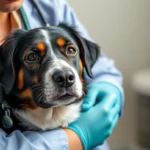
Introduction
Stomach tacking in dogs, known medically as gastropexy, is a surgical procedure designed to prevent serious gastrointestinal issues, particularly gastric dilatation-volvulus (GDV), commonly referred to as bloat. This condition can be life-threatening and is characterized by the stomach filling with gas and possibly twisting, leading to severe complications. Understanding gastropexy is crucial for dog owners, especially those with breeds predisposed to bloat.
In this article, we will delve into the intricacies of stomach tacking in dogs gastropexy, exploring its necessity, procedure, benefits, risks, and recovery. This information is vital for dog owners to make informed decisions about their pets’ health.
Understanding Gastropexy
What is Gastropexy?
Gastropexy is a surgical procedure that involves attaching the stomach to the abdominal wall to prevent it from twisting. By anchoring the stomach in its normal position, this procedure significantly reduces the risk of GDV.
Unlike other surgical interventions for gastrointestinal issues, which may address existing problems, gastropexy is often performed as a preventive measure, especially for high-risk breeds. This proactive approach helps avoid the severe consequences of bloat, which can include shock, organ failure, and, in some cases, death.
Why is Gastropexy Performed?
The primary reason for performing gastropexy is to prevent gastric dilatation-volvulus. Studies indicate that GDV affects approximately 6-8% of deep-chested dog breeds, such as Great Danes, German Shepherds, and Boxers. The incidence rate of GDV in these breeds is alarmingly high, making gastropexy a crucial consideration for owners.
Types of Gastropexy Procedures
There are two main types of gastropexy procedures: traditional and laparoscopic techniques.
-
Traditional Gastropexy: This method involves making a larger incision in the abdomen to access the stomach and attach it to the abdominal wall. Recovery time can range from 10 to 14 days, during which the dog must be closely monitored.
-
Laparoscopic Gastropexy: This minimally invasive technique uses small incisions and specialized instruments, resulting in less pain and quicker recovery. Dogs typically return to normal activities within 7 to 10 days.
Both methods are effective, but the choice often depends on the veterinarian’s expertise and the specific needs of the dog.
Symptoms Indicating the Need for Gastropexy
Common Signs of Gastrointestinal Distress
Recognizing the signs of gastrointestinal distress is vital for early intervention. Common symptoms include:
- Bloating and distension: A visibly swollen abdomen can indicate that gas is trapped in the stomach.
- Unsuccessful vomiting or retching: Dogs may attempt to vomit without producing anything, a classic sign of GDV.
- Signs of pain or discomfort: Whining, pacing, or a hunched posture can indicate that a dog is in distress.
Risk Factors for Developing Gastric Torsion
Certain breeds are predisposed to developing gastric torsion. Deep-chested breeds, such as:
- Great Danes
- Doberman Pinschers
- St. Bernards
- Irish Setters
are particularly at risk. Environmental factors, such as rapid eating, exercise after meals, and stress, can also contribute to the likelihood of GDV.
The Gastropexy Procedure
Pre-Surgical Considerations
Before performing gastropexy, veterinarians will conduct a thorough consultation, including a detailed history of the dog’s health and behavior. Recommended pre-operative tests may include:
- Blood tests: To assess overall health and identify any underlying conditions.
- X-rays: To evaluate the stomach’s position and rule out existing distension or torsion.
The Surgical Process
The gastropexy procedure itself typically lasts about 30 to 60 minutes. The veterinarian will:
- Induce anesthesia and prepare the surgical site.
- Make an incision in the abdomen (traditional) or create small incisions (laparoscopic).
- Secure the stomach to the abdominal wall using sutures.
Most dogs require general anesthesia, and the veterinarian will ensure they are closely monitored throughout the procedure.
Post-Operative Care
Post-surgery, immediate recovery involves monitoring for any adverse reactions to anesthesia. Dogs may experience some discomfort, but this can be managed with pain medications. Long-term care guidelines include:
- Diet: Gradually reintroducing food, starting with a bland diet.
- Activity restrictions: Limiting vigorous exercise for at least 2 weeks to allow the abdominal wall to heal.
Regular follow-up appointments with the veterinarian are crucial to ensure proper healing and to watch for any potential complications.
Benefits of Gastropexy
Preventive Measures
One of the most significant benefits of gastropexy is its ability to prevent gastric torsion. For high-risk breeds, this preventive measure can be life-saving. Studies show that dogs who undergo this procedure have a significantly lower incidence of GDV compared to those who do not.
Quality of Life Improvements
Many dog owners report noticeable improvements in their pets’ overall health and wellbeing after gastropexy. Dogs often exhibit increased energy levels and less gastrointestinal distress. Testimonials from owners highlight happier, healthier dogs post-surgery, reinforcing the procedure’s value.
Risks and Complications
Potential Surgical Risks
As with any surgical procedure, there are risks associated with gastropexy. Common surgical complications include:
- Infection: Post-operative infections can occur but are generally manageable with antibiotics.
- Anesthesia risks: Though rare, reactions to anesthesia can happen, especially in older dogs or those with pre-existing conditions.
Long-Term Considerations
While gastropexy significantly reduces the risk of GDV, it does not eliminate it entirely. There is a possibility of recurrence of gastrointestinal issues, especially in dogs with a history of bloat. Owners should remain vigilant for any signs of distress and consult their veterinarian if symptoms arise.
FAQs About Gastropexy
Common Questions from Dog Owners
-
What breeds are most at risk for bloat?
Deep-chested breeds, including Great Danes, Doberman Pinschers, and Boxers, are particularly susceptible. -
How can I prepare my dog for surgery?
Follow your veterinarian’s pre-operative instructions, which may include fasting your dog for a specified period before surgery. -
What is the recovery timeline like?
Recovery typically takes 7 to 14 days, depending on the surgical technique used and the individual dog’s health.
Expert Answers
Veterinarians emphasize the importance of monitoring your dog closely during the recovery phase and following all post-operative care instructions. Keeping an eye on their eating habits and activity levels is crucial to ensure a smooth recovery.
Conclusion
Stomach tacking in dogs gastropexy is a critical procedure for preventing the life-threatening condition of gastric dilatation-volvulus. Understanding the procedure, its benefits, and potential risks can empower dog owners to make informed decisions regarding their pets’ health. Regular consultations with your veterinarian are essential, especially if your dog is at risk or shows symptoms of gastrointestinal distress. Being proactive is key to ensuring a long, healthy life for your furry companion.









